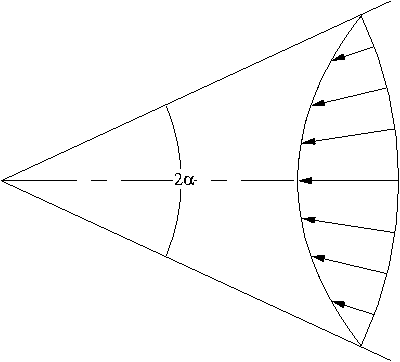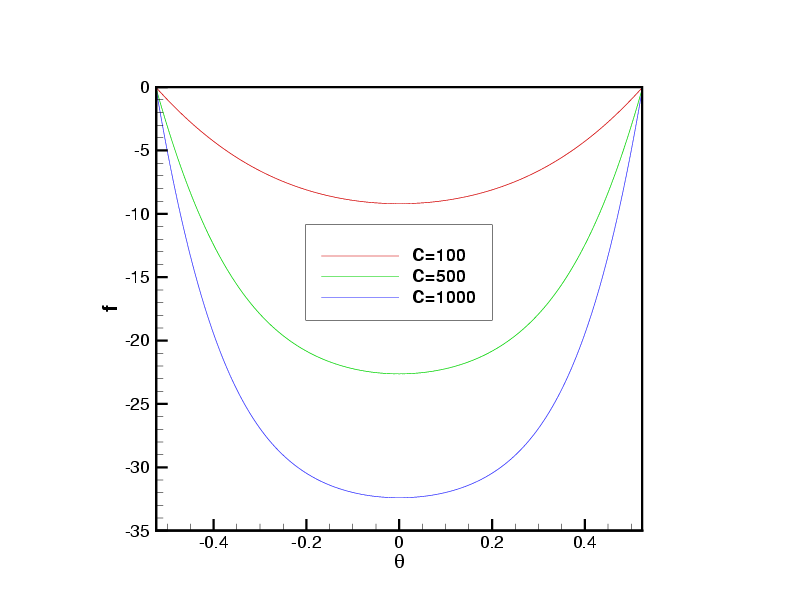Jeffery-Hamel flow
From CFD-Wiki
Contents |
Introduction
The flow between two planes that meet at an angle was first analyzed by Jeffery (1915) and Hamel (1916). Under suitable assumptions, the problem can be reduced to the solution of an ordinary differential equation. This ODE can be readily solved using various numerical techniques. This case is analyzed in several of the standard texts, including Batchelor and Landau and Lifshitz.
The flow geometry is shown in the figure below. The two plates
confining the flow meet at an angle of  , and the
flow can be either diverging or converging (shown in the figure).
, and the
flow can be either diverging or converging (shown in the figure).
The volume flow rate may be computed from

at a specified radius  . For
. For  positive the
flow is diverging, while for
positive the
flow is diverging, while for  negative the flow is
converging. The converging-flow case is of more interest as a test
case since the diverging case may not be as stable (or steady) as the
converging case. The appropriate Reynolds number is usually taken to
be a function of the volume flow rate. Here, we will follow Rosenhead
and use
negative the flow is
converging. The converging-flow case is of more interest as a test
case since the diverging case may not be as stable (or steady) as the
converging case. The appropriate Reynolds number is usually taken to
be a function of the volume flow rate. Here, we will follow Rosenhead
and use

Similarity Solution
The flow is assumed to be purely radial and steady, or that  and
and  with no-slip conditions at
with no-slip conditions at  .
.
The Navier-Stokes equations in cylindrical coordinates then reduce to
![v_r\frac{\partial v_r}{\partial r} = -\frac{1}{\rho}\frac{\partial p}{\partial r} + \nu \left[\frac{1}{r}\frac{\partial}{\partial r}\left(r\frac{\partial v_r}{\partial r}\right) + \frac{1}{r^2}\frac{\partial^2 v_r}{\partial \theta^2} - \frac{v_r}{r^2}\right]](/W/images/math/6/1/1/6112a078ddf16b1e2a324d7b54f0d538.png)


The continuity equation reduces to

which requires that  be independent of
be independent of
 . This leads us to look for solutions of the form
. This leads us to look for solutions of the form

where  is a function of
is a function of  only.
Substituting into the azimuthal momentum equation and integrating
once, we obtain
only.
Substituting into the azimuthal momentum equation and integrating
once, we obtain

where  is a function of
is a function of  only.
Substituting into the radial momentum equation, we find
only.
Substituting into the radial momentum equation, we find

Since the left hand side is a function of  only and
the right-hand side is a function of
only and
the right-hand side is a function of  only, both must be
constant. This gives an ODE for
only, both must be
constant. This gives an ODE for  :
:

and, after an integration, an expression for pressure:

where  is a constant of integration.
is a constant of integration.
The constant  must be chosen before a solution can be
found. It should be noted that various authors have used cosmetically
different definitions for
must be chosen before a solution can be
found. It should be noted that various authors have used cosmetically
different definitions for  , which leads to cosmetically
different ODE's.
, which leads to cosmetically
different ODE's.
The Reynolds number for this case is usually based upon the volume
flow rate  , which can now be written as
, which can now be written as

The Reynolds number is then

Solution
The elliptic function solutions of Rosenhead and others are not very
convenient for comparison purposes, so it is easier to compute a
numerical solution to the similarity ODE. There problem can be solved
as a boundary value problem (as it is), or it can be converted into an
initial value problem and solved via a shooting method. Both
approaches should produce acceptable results provided that sufficient
care is taken. Shown below are the results for three converging-flow calculation using a Newton iteration technique for three values of  .
.
References
Jeffery, G. B. (1915), "The Two-Dimensional Steady Motion of a Viscous Fluid", Philosophical magazine, Vol. 29, pp. 455-465.
Hamel, G. (1916), "Spiralfömrige Bewegungen zäher Flüssigheiten", Jahresbericht der Deutschen Mathematiker-Vereinigung, Vol. 25, pp. 34-60.
Rosenhead, L. (1940), "The Steady Two-Dimensional Radial Flow of Viscous Fluid between Two Inclined Plane Walls", Proceedings of the Royal Society of London. Series A, Mathematical and Physical Sciences, Vol. 175, No. 963, pp. 436-467.


